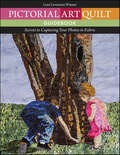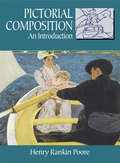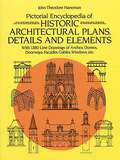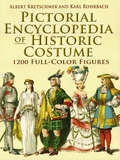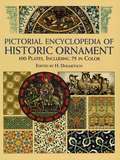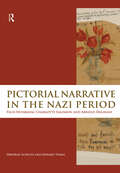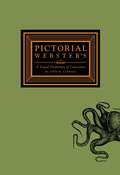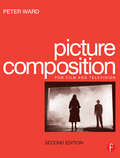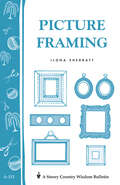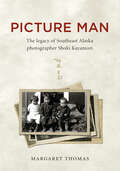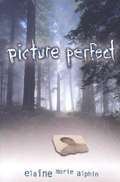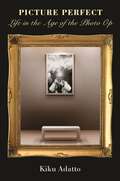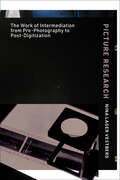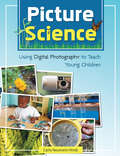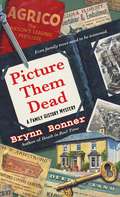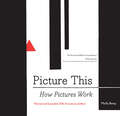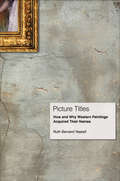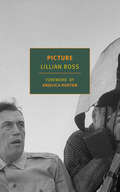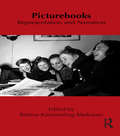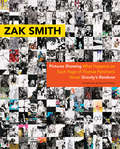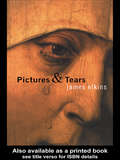- Table View
- List View
Pictorial Art Quilt Guidebook: Secrets to Capturing Your Photos in Fabric
by Leni Levenson WienerTurn photos into fabulous fabric art collages You’ll be surprised how easy it is to transform a photo into gallery-worthy fabric art with Leni Wiener’s simple methods. Leni walks you step by step through choosing the right fabrics; creating patterns with free software; depicting common elements, such as grass, trees, water, and faces; layering and sewing your collages; and finishing your work for display. Loaded with inspiring photos, this guide is a virtual art class in a book. • Complete patterns and instructions for two quilts help get you started • Use the included Art Quilter’s Value Scale to choose the perfect fabrics for your quilts
Pictorial Composition: An Introduction
by Henry Rankin PooreA painting's technique, color, and perspective may all be excellent, yet the painting will fail unless its composition succeeds. Composition is the harmonious arranging of the component parts of a work of art into a unified whole. Henry Poore examines the works of old masters and moderns in this book and uses these examples to explain the principles of compositions in art.All the paintings that the author analyzes are illustrated in the text -- 166 illustrations, including 9 in full color. Thirty-two diagrams by the author accompany his textural discussion of such topics as the importance of balance, entrance and exit, circular observation, angular composition, composition with one or more units, and light and shade. Balance is the most important of these topics, and it is considered in the greatest detail -- balance of the steelyard, vertical and horizontal balance, and so on. A complete index enables the reader to locate his own specific areas of interest.To see how a painting by Cézanne, Goya, or Hopper, for example, follows definite principles of composition allows the practicing artist or art student to learn composition from the finest instructors -- the artists themselves. This book is also very useful to the art devotee, who will find his appreciation of the subject greatly enhanced.
Pictorial Encyclopedia of Historic Architectural Plans, Details and Elements: With 1880 Line Drawings of Arches, Domes, Doorways, Facades, Gables, Windows, etc. (Dover Architecture Ser.)
by John Theodore HanemanAnyone seeking to understand the basic principles underlying architectural design will find this classic source book an invaluable addition to the bookshelf. Haneman's 1,800 captioned, clear line drawings on 70 large-size plates comprise an inexhaustible storehouse of suggestion and inspiration for architects, designs, preservationists and others.Presented here are hundreds of details covering scores of architectural elements, including aisles, approaches, balconies, columns, doorways, dormers, fireplaces, mantels, plazas, ramps, roofs, stairs, wells, windows, and much more.The work offers more than 50 details of chimneys alone, ranging from those at the side of a building to a less than usual variant terminating in an octagonal campanile.All designs emphasize general architectural concepts and are applicable to a broad range of styles. They are systematically arranged and grouped — a cross-referenced table of contents doubles as an index. All information is thus readily accessible and easily located. Bibliography. Captions.
Pictorial Encyclopedia of Historic Costume: 1200 Full-Color Figures
by Albert Kretschmer Karl RohrbachRanging from the elegant garments worn by citizens of ancient Egypt, Greece, and Rome to the dramatic clothing of nineteenth-century French, English, and German societies, this stunning pictorial encyclopedia chronicles the full sweep of historic dress through the centuries.Carefully gathered from a rare portfolio originally published in 1906, over one thousand detailed engravings are presented here in a continuous chronological format. An unparalleled history of costume design, this collection includes the garb of kings and laborers ... ladies and warriors ... peasants and priests. Scores of accessories are also illustrated, including shoes, jewelry, wigs, and hair ornaments, along with furniture, musical instruments, and weaponry from a fascinating array of time periods. Exquisitely rendered and magnificent in scope, the Pictorial Encyclopedia of Historic Costume is a visual delight for designers, artists, historians, and everyone captivated by fashion's timeless allure.
Pictorial Encyclopedia of Historic Ornament: 100 Plates, Including 75 in Full Color
by H. DolmetschOne of the great anthologies of historic ornament and design. A veritable treasure chest of royalty-free images, arranged chronologically: Roman architecture and sculpture, Byzantine embroidery, and illuminated manuscripts; Italian glass painting, pottery, and French tapestries from the Renaissance; mosaic floors, painted plasterwork, and metal ornaments. Over 1,500 color and black-and-white illustrations.
Pictorial Narrative in the Nazi Period: Felix Nussbaum, Charlotte Salomon and Arnold Daghani
by Edward Timms Deborah SchultzThis book investigates creative responses to the Nazi period in the work of three artists, Felix Nussbaum, Charlotte Salomon and Arnold Daghani, focusing on their use of pictorial narrative. It analyses their contrasting aesthetic strategies and their innovative forms of artistic production. In contrast with the autonomous, modernist art object, their works were explicitly linked with the historical conditions under which they were produced – the pressures of persecution and exile. Conditions in the slave labour camps and ghettos in the Ukraine, which shaped the paintings and drawings of Daghani, are contrasted with the experiences of exile in Belgium and France, which inspired Nussbaum and Salomon. In defiance of conventional artistic practice, they produced word-image combinations that can be read as narrative sequences, incorporating specific references to political events. While there has been a wealth of literary, philosophical and historical studies relating to the Holocaust, aesthetic debate has developed less extensively. This is the first comparative study of three artists who are only belatedly achieving recognition and the recent reception of their work is evaluated. By identifying the aesthetic principles and narrative strategies underlying their work, the book reassesses their achievement in creating new forms of modernism with an unmistakable political momentum.This book was published as a special issue of Word & Image.
Pictorial Webster's
by John M. CarreraFeaturing over 1,500 engravings that originally graced the pages of Webster's dictionaries in the 19th century, this volume is an irresistible treasure trove for art lovers, designers, and anyone with an interest in visual history. Meticulously cleaned and restored by fine-press bookmaker Johnny Carrera, the engravings in Pictorial Webster's have been compiled into an alluring and unusual visual reference guide for the modern day. Images range from the entirely mysterious to the classically iconic. From Acorns to Zebras, Bell Jars to Velocipedes, these alphabetically arranged archetypes and curiosities create enigmatic juxtapositions and illustrate the items deemed important to the Victorian mind. Sure to inspire and delight, Pictorial Webster's is at once a fascinating historical record and a stunning jewel of a book.
Picture Composition
by Peter WardBehind each shot there lies an idea or purpose. When setting up a shot, the camera operator can employ a range of visual techniques that will clearly communicate the idea to an audience. Composition is the bedrock of the operator's craft, yet is seldom taught in training courses in the belief that it is an intuitive, personal skill. Peter Ward shows how composition can be learned, to enhance the quality of your work. Based on the author's own practical experience, the book deals with the methods available for resolving practical production questions such as: Does the shot composition accurately reflect the idea that initiated the shot? Will the content and method of presenting the subject accurately convey the idea? Major innovations in television and film production since the previous edition have affected the styles of composition, such as wide-screen and the use of mini DV cameras. These new technologies and their implications for picture composition are addressed in this new edition. A new colour plate section is also being included to update the section on colour. If you are a practising camera operator, trainee camera operator, student or lecturer on a television or film production course, or simply a video enthusiast wishing to progress to a more professional standard you will find this book essential in enhancing the quality of your work.
Picture Framing: Storey's Country Wisdom Bulletin A-153 (Storey Country Wisdom Bulletin Ser.)
by Ilona SherrattSince 1973, Storey's Country Wisdom Bulletins have offered practical, hands-on instructions designed to help readers master dozens of country living skills quickly and easily. <P><P>There are now more than 170 titles in this series, and their remarkable popularity reflects the common desire of country and city dwellers alike to cultivate personal independence in everyday life.
Picture History of World War II American Aircraft Production
by Joshua StoffOver 250 rare photographs depict one of the greatest industrial feats of World War II: the massive production of American military aircraft. Photos show teams of workers turning out Boeing B-17 bombers in Seattle, huge B-24D Liberators at the Ford plant in Willow Run, F6F Grumman Hellcat fighters in Long Island, and much more.
Picture Man: The Legacy of Southeast Alaska Photographer Shoki Kayamori
by Margaret ThomasIn 1912, Shoki Kayamori and his box camera arrived in a small Tlingit village in southeast Alaska. At a time when Asian immigrants were forbidden to own property and faced intense racial pressure, the Japanese-born Kayamori put down roots and became part of the Yakutat community. For three decades he photographed daily life in the village, turning his lens on locals and migrants alike, and gaining the nickname “Picture Man.” But as World War II drew near, his passion for photography turned dangerous, as government officials called out Kayamori as a potential spy. Despondent, Kayamori committed suicide, leaving behind an enigmatic photographic legacy. In Picture Man, Margaret Thomas views Kayamori’s life through multiple lenses. Using Kayamori’s original photos, she explores the economic and political realities that sent Kayamori and thousands like him out of Japan toward opportunity and adventure in the United States, especially the Pacific Northwest. She reveals the tensions around Asian immigrants on the West Coast and the racism that sent many young men north to work in the canneries of Alaska. And she illuminates the intersecting—and at times conflicting—lives of villagers and migrants in a time of enormous change. Part history, part biography, part photographic showcase, Picture Man offers a fascinating new view of Alaska history.
Picture Perfect
by Elaine Marie AlphinWhen his best friend vanishes, Ian sets out to discover what happened. A gap in his memory the afternoon that his best friend disappears in a redwood forest has a fifteen-year-old photographer wondering about his own role in the mystery, and who he can turn to for help.
Picture Perfect Knits
by Sheri Giblin Laura BirekJust what the heck is intarsia anyway? One of the most overlooked knitting techniques, intarsia allows knitters to add graphics--think argyle diamonds or mod motifsto their knits. There's no tricky double stranding and knitters can incorporate intarsia into almost any project--be it a cozy blanket or tiny mittens. This handy guide includes instructions to make 12 projects plus more than 50 intarsia graphs that can be used to customize almost any knit. Clear instructions, helpful illustrations, and finished project photos make it simple to learn the basics. There are even some blank charts so knitters can invent their own patterns. It's easy. It's fun. And the results are totally picture perfect!Special guest designers include: Lena Corwin, Jenny Hart of Sublime Stitching, Sarah Neuberger of Small Object, Shannon Okey of Knitgrrl, Denyse Schmidt, and more!
Picture Perfect: Life in the Age of the Photo Op - New Edition
by Kiku AdattoWe say the camera doesn't lie, but we also know that pictures distort and deceive. In Picture Perfect, Kiku Adatto brilliantly examines the use and abuse of images today. Ranging from family albums to Facebook, political campaigns to popular movies, images of war to pictures of protest. Adatto reveals how the line between the person and the pose, the real and the fake, news and entertainment is increasingly blurred. New technologies make it easier than ever to capture, manipulate, and spread images. But even in the age of the Internet, we still seek authentic pictures and believe in the camera's promise to document, witness, and interpret our lives.
Picture Research: The Work of Intermediation from Pre-Photography to Post-Digitization
by Nina Lager VestbergAn intimate foray into the invisible work that made it possible for pictures to circulate in print and online from the 1830s to the 2010s.Picture Research focuses on how pictures were saved, stored, and searched for in a time before scanners, servers, and search engines, and describes the dramatic difference it made when images became scannable, searchable, and distributable via the internet. While the camera, the darkroom, and the printed page are well-known sites of photographic production that have been replaced by cell phones, imaging software, and websites, the cultural intermediaries of mass-circulation photography—picture librarians and researchers, editors, and archivists—are less familiar. In this book, Nina Lager Vestberg artfully details the range of research skills, reproduction machinery, and communication infrastructures that was needed to make pictures available to a public before digitization.Drawing on documents and representations across a range of cultural expressions, Picture Research reveals the intermediation that has been performed by skilled workers in a variety of roles, making use of pre-photographic, photographic, and digital machineries of capture, accumulation, extraction, and transmission. Tracing a history of the modern pictorial economy from the pre-photographic 1830s to the post-digitized 2010s, it makes visible and explicit the invisible labor that has built—and still sustains—the visual commodity culture of everyday life.
Picture Science
by Carla Neumann-HindsMake digital photography an important part of your early childhood program!Young children love to investigate the natural world, and they love to take photographs.Picture Science will help you go beyond just documenting class projects. It will show you how to use digital photography to make each step in the scientific process-from posing a question, to gathering data, to showing your findings-concrete and fun for children.Keyed throughout to early learning standards, Picture Science provides inspiring examples that will stimulate you to design your own lesson plans. Technical advice and tips for buying a camera for your center or family child care business are included as well.Picture Science won the prestigious 2007 Directors' Choice Award and Judges' Selection Award from Early Childhood News
Picture Them Dead (A Family History Mystery #3)
by Brynn BonnerIn this third cozy whodunit in the Family History Mystery series, a professional genealogist duo searches for the link between a death from long ago and a modern-day murder.As a professional genealogist, I’ve seen enough skeletons come dancing out of closets to get a respectable conga line formed up. But they’ve always been metaphorical skeletons. Until today. When genealogists Sophreena McClure and Esme Sabatier are called on by Detective Jenny Jeffers to help figure out who the corpse in the backyard of her father’s house is, they reluctantly agree. Known for figuring out the unusual, Sophreena and Esme do their best to uncover the mystery behind the corpse, and the glass coffin he’s buried in. Word soon spreads about the bizarre burial site, leading the people of Morningside to “adopt” the corpse and begin leaving mementos in memoriam for him. But when the body of a young woman is found near the memorial, the duo has another task on their hands: to dig into the past of the house’s previous owners. Could the clues to a recent murder finally help this soul rest in peace?
Picture This: How Pictures Work
by Molly BangMolly Bang's brilliant, insightful, and accessible treatise is now revised and expanded for its 25th anniversary. Bang's powerful ideas—about how the visual composition of images works to engage the emotions, and how the elements of an artwork can give it the power to tell a story—remain unparalleled in their simplicity and genius. Why are diagonals dramatic? Why are curves calming? Why does red feel hot and blue feel cold? First published in 1991, Picture This has changed the way artists, illustrators, reviewers, critics, and readers look at and understand art.
Picture Titles
by Ruth Bernard YeazellA picture's title is often our first guide to understanding the image. Yet paintings didn't always have titles, and many canvases acquired their names from curators, dealers, and printmakers--not the artists. Taking an original, historical look at how Western paintings were named, Picture Titles shows how the practice developed in response to the conditions of the modern art world and how titles have shaped the reception of artwork from the time of Bruegel and Rembrandt to the present.Ruth Bernard Yeazell begins the story with the decline of patronage and the rise of the art market in the seventeenth and eighteenth centuries, as the increasing circulation of pictures and the democratization of the viewing public generated the need for a shorthand by which to identify works at a far remove from their creation. The spread of literacy both encouraged the practice of titling pictures and aroused new anxieties about relations between word and image, including fears that reading was taking the place of looking. Yeazell demonstrates that most titles composed before the nineteenth century were the work of middlemen, and even today many artists rely on others to name their pictures. A painter who wants a title to stick, Yeazell argues, must engage in an act of aggressive authorship. She investigates prominent cases, such as David's Oath of the Horatii and works by Turner, Courbet, Whistler, Magritte, and Jasper Johns. Examining Western painting from the Renaissance to the present day, Picture Titles sheds new light on the ways that we interpret and appreciate visual art.
Picture: Rodando Con Huston (Modern Library)
by Lillian RossA classic look at Hollywood and the American film industry by The New Yorker's Lillian Ross, and named one of the "Top 100 Works of U.S. Journalism of the Twentieth Century."Lillian Ross worked at The New Yorker for more than half a century, and might be described not only as an outstanding practitioner of modern long-form journalism but also as one of its inventors. Picture, originally published in 1952, is her most celebrated piece of reportage, a closely observed and completely absorbing story of how studio politics and misguided commercialism turn a promising movie into an all-around disaster. The charismatic and hard-bitten director and actor John Huston is at the center of the book, determined to make Stephen Crane’s The Red Badge of Courage—one of the great and defining works of American literature, the first modern war novel, a book whose vivid imagistic style invites the description of cinematic—into a movie that is worthy of it. At first all goes well, as Huston shoots and puts together a two-hour film that is, he feels, the best he’s ever made. Then the studio bosses step in and the audience previews begin, conferences are held, and the movie is taken out of Huston’s hands, cut down by a third, and finally released—with results that please no one and certainly not the public: It was an expensive flop. In Picture, which Charlie Chaplin aptly described as “brilliant and sagacious,” Ross is a gadfly on the wall taking note of the operations of a system designed to crank out mediocrity.
Picturebooks: Representation and Narration (Children's Literature and Culture)
by Bettina Kümmerling-MeibauerThis volume discusses the aesthetic and cognitive challenges of modern picturebooks from different countries, such as Denmark, France, Germany, Norway, Spain, Sweden, United Kingdom, and USA. The overarching issue concerns the mutual relationship between representation and narration by means of the picturebooks’ multimodal character. Moreover, this volume includes the main lines of debate and approaches to picturebooks by international leading researchers in the field. Topics covered are the impact of paratexts and interpictorial allusions, the relationship between artists’ books, crossover picturebooks, and picturebooks for adults, the narrative defiance of wordless picturebooks, the representation of emotions in images and text, and the depiction of hybrid characters in picturebooks. The enlargement of the picturebook corpus beyond an Anglo-American picturebook canon opens up new horizons and highlights the diverging styles and genre shifts in modern picturebooks. This tendency also demonstrates the influence of specific authors and illustrators on the appreciation of the picturebook genre, as in the case of Astrid Lindgren’s picturebooks and the picturebooks created by renowned illustrators, such as Anthony Browne, Wolf Erlbruch, Stian Hole, and Bruno Munari. This book will be the definite contribution to contemporary picturebook research for many years to come.
Pictures Showing What Happens on Each Page of Thomas Pynchon's Novel Gravity's Rainbow
by Steve Erickson Zak SmithGravity's Rainbow Illustrated: One Picture for Every Page features the work of an Ivy League-educated, punk-rock, porn-star visual artist who has created a drawing for every page of a novel that is widely considered to be the most difficult work of literature ever produced in English. Thomas Pynchon's Gravity's Rainbow (1973) has been called a modernFinnegans Wake for its challenging language, wild anachronisms, hallucinatory happenings, and fever-dream imagery. With Pictures Showing What Happens on Each Page of Thomas Pynchon's Novel Gravity's Rainbow, artist Zak Smith at once eases and expands readers' experience of the twentieth-century classic. Smith has created more than 750 pages of drawings, paintings, and photos--each derived from a page of Pynchon's novel. Extraordinary tableaux of the detritus of war--a burned-out Konigstiger tank, a melted machine gun--coexist alongside such fantasmagoric Pynchon inventions as the "stumbling bird" and "Grigori the octopus." Smith has said he aimed to be "as literal as possible" in interpreting Gravity's Rainbow, but his images are as imaginative and powerful as the prose they honor.
Pictures Showing What Happens on Each Page of Thomas Pynchon's Novel Gravity's Rainbow
by Steve Erickson Zak SmithThomas Pynchon's Gravity's Rainbow (1973), set in an alternative-universe version of World War II, has been called a modern Finnegan's Wake for its challenging language, wild anachronisms, hallucinatory happenings, and fever-dream imagery. With Pictures Showing What Happens on Each Page of Thomas Pynchon's Novel Gravity's Rainbow, artist Zak Smith at once eases and expands readers' experience of the book. A leading exponent of punk-based, DIY art, Smith here presents his most ambitious project to date - an art book exactly as long as the work it's interpreting: 760 drawings, paintings, photos, and less definable images in 760 pages. Extraordinary tableaux of the detritus of war - a burned-out Königstiger tank, a melted machine gun - coexist alongside such phantasmagoric Pynchon inventions as the "stumbling bird" and "Girgori the octopus." Smith has stated his aim to be "as literal as possible" in interpreting Gravity's Rainbow, but his images are as imaginative and powerfully unique as the prose they honor.
Pictures Showing What Happens on Each Page of Thomas Pynchon's Novel Gravity's Rainbow
by Steve Erickson Zak SmithGravity's Rainbow Illustrated: One Picture for Every Page features the work of an Ivy League-educated, punk-rock, porn-star visual artist who has created a drawing for every page of a novel that is widely considered to be the most difficult work of literature ever produced in English. Thomas Pynchon's Gravity's Rainbow (1973) has been called a modernFinnegans Wake for its challenging language, wild anachronisms, hallucinatory happenings, and fever-dream imagery. With Pictures Showing What Happens on Each Page of Thomas Pynchon's Novel Gravity's Rainbow, artist Zak Smith at once eases and expands readers' experience of the twentieth-century classic. Smith has created more than 750 pages of drawings, paintings, and photos--each derived from a page of Pynchon's novel. Extraordinary tableaux of the detritus of war--a burned-out Konigstiger tank, a melted machine gun--coexist alongside such fantasmagoric Pynchon inventions as the "stumbling bird" and "Grigori the octopus." Smith has said he aimed to be "as literal as possible" in interpreting Gravity's Rainbow, but his images are as imaginative and powerful as the prose they honor.
Pictures and Tears: A History of People Who Have Cried in Front of Paintings
by James ElkinsArt Does art leave you cold? And is that what it's supposed to do? Or is a painting meant to move you to tears? Hemingway was reduced to tears in the midst of a drinking bout when a painting by James Thurber caught his eye. And what's bad about that? In Pictures and Tears, art historian James Elkins tells the story of paintings that have made people cry. Drawing upon anecdotes related to individual works of art, he provides a chronicle of how people have shown emotion before works of art in the past, and a meditation on the curious tearlessness with which most people approach art in the present. Deeply personal, Pictures and Tears is a history of emotion and vulnerability, and an inquiry into the nature of art. This book is a rare and invaluable treasure for people who love art. Also includes an 8-page color insert.
